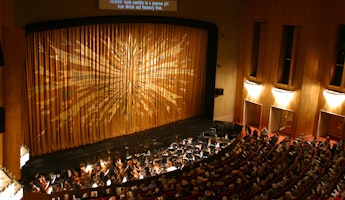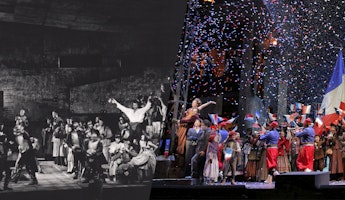Blog
March 19, 2024
From Obscene "Trivialità" to "Traviata"
A Note from Music Director James Conlon
The third of Giuseppe Verdi’s so-called “middle-period trilogy” of masterpieces, La Traviata is arguably not only Verdi’s most popular opera, but one of a handful of the world’s most beloved operas. Several years after the trilogy was completed, when the composer was asked what his best opera was, he answered: “Speaking as a professional, Rigoletto; speaking as an amateur, La Traviata.”
I have often mused on what he meant by this statement. La Traviata (the euphemistic title can be translated as “a woman led astray” or “corrupted”) has always spoken directly to the hearts of opera lovers. Its wealth of melodic invention and expressive vocalism, so perfectly wed to the touching and tragic love story, reverberated on a personal level not only with its creator, but with the opera-loving public ever since.
This middle-period trilogy (a posthumous term) consists of Rigoletto (premiered on March 11, 1851), Il Trovatore (January 19, 1853) and La Traviata (March 6, 1853). I cite the dates of the premieres lest anyone overlook the fact that Verdi wrote them in an astonishingly short time, two of them virtually simultaneously. Not surprisingly, the music of each of the three works resembles the others. Yet hidden amongst the similarities, Rigoletto and La Traviata, in their different ways, clearly inaugurate the future, whereas Il Trovatore, standing as it does as the crowning achievement of the past, provides closure on a type of Verdian melodrama par excellence, before opening the way of the future. That. Trovatore and Traviata, written so closely together, are so different, is remarkable. Rigoletto and La Traviata inhabit the vestibule of the future. Like the head of Janus, these works simultaneously look backward—in some ways for the last time—but irrevocably point forward.
I would like to isolate one aspect of a common characteristic of the three masterpieces that is sometimes overlooked. Some might consider these works to be “old fashioned.” I completely disagree. In fact, in the context of Italian theater of the early 1850s, they are not just daring, bold and shocking, but, in their way, revolutionary.
Verdi’s theatrical genius led him ceaselessly to search for interesting dramatic material. Europe had been rocked by political upheaval and revolution in 1848, and the composer keenly felt the shock waves. His lifelong pursuit of popular appeal led him to eschew much of the formulaic opera libretti of the previous century. He forswore mythology, ancient Greece, Rome and even Italian subjects. French, English, German and Spanish sources abound, and it is from Victor Hugo, Antonio García Gutiérrez and Alexandre Dumas fils that he found the sources for this extraordinary trilogy.
The common thread that weaves through these works is the presentation of tragic protagonists who belong to categories of contemporary society’s cast-offs. Verdi saw the potential for explosive dramatic material in the lives and fates of a misanthropic hunchbacked jester, a tragically crazed Roma woman (her race still despised and marginalized throughout European history) and a Parisian courtesan,
The genius is not only in the choice, but also in the rendering. We empathize with Rigoletto, despite his physical handicaps, because of his tender love for his daughter. Misshapen people, dwarfs and hunchbacks were considered appropriate only for circus acts and comic relief, not as tragic protagonists. Hugo and Verdi challenged that view, just as Oscar Wilde and Alexander Zemlinsky were to do subsequently in The Dwarf (Der Zwerg). While explaining to a colleague, the composer wrote, "Everyone cried out at the idea of putting a hunchback on the stage; well, there you are. I was very happy to write Rigoletto".
The place for Roma women was as secondary characters to provide some sort of local color. They told fortunes, danced or engaged in some sort of illegal or illicit commerce. Until Georges Bizet's Carmen was to break the mold 20 years later, there were no true tragic heroines coming from the Roma people. Azucena’s plight (however farfetched the plot of Il Trovatore) wins our hearts, despite her reviled origins. Verdi allows both the ugly court jester and the tragic Roma mother to point an accusatory finger at the societies responsible for their abject existences, blaming their own wickedness on society and their environment.
Violetta accuses no one, loves fully and even extravagantly, admirably assumes total responsibility for her life, and tragically dies of consumption less than a month past her 23rd birthday. She turns her society’s hypocrisy on its head, demonstrates that this woman of “fallen virtue” personifies genuine love, in contrast to almost all of the drama's other characters who are either frivolous and superficial or—in the case of Germont, the father of her beloved Alfredo—proponents of bourgeois morality. Verdi, by portraying a consumptive courtesan as a heroine, a symbol and incarnation of generous and boundless love, struck an unexpected chord in the history of Italian opera.
As Verdi dashed off Il Trovatore and La Traviata for their premieres separated by only five weeks, Richard Wagner was finishing the text of The Ring of the Nibelung. While Verdi’s Teutonic contemporary posited that myths were the strongest subjects for music dramas, Verdi’s brand of Italian melodrama was rooted in realism. Out of his 26 operas, La Traviata is the only one based on a contemporary subject, yet another example of the audacity of Verdi's choice of subject. Though he wanted it played in contemporary dress, he was obliged to defer to the Teatro Fenice's expectations and back-date the story to the 18th century. Eschewing myth for realism, he effectively evoked an ancient biblical theme of the fallen woman and her redemption. The success of his masterwork bestowed the status of myth on his heroine, to survive into our time long after Dumas' novel and play were to fade from view, just as Mozart and Da Ponte conferred immortality on unscrupulous, immoral and destructive Don Juan.
An historical inhabitant of the Parisian demimonde, a poor country girl, Marie Duplessis, rose with exceptional speed through the stratospheric social levels of French society. (The great composer Franz Liszt, was among her numerous lovers.) French author Alexander Dumas fils, also smitten with her, transformed her into the fictional Marguerite Gautier, heroine of both his novel and play called La Dame aux Camélias (The Woman of the Camelias). Verdi named her Violetta Valéry. Her complex, contradictory and intriguing personality has fascinated many. Since the first film version of her story in 1911, there have been more than a dozen major renditions on screen, including those featuring Sarah Bernhardt, Greta Garbo and Isabelle Huppert.
The tragedy of La Traviata is essentially that of an impossible love overtaken by premature death, whose looming omnipresence is established in the first bar of the prelude. Violetta (whose name evokes violet, the traditional color of death, mourning and penitence on the Italian peninsula) is condemned to an early demise by incurable tuberculosis. She has risen from a childhood of abuse and misery to become a cultivated young woman of intelligence and depth with a profound capacity to love, only to succumb at the moment of reconciliation with her lover, his father and, one would like to imagine, society.
It is the tragedy of the collision of the values of this authentic love with the rigidity of provincial bourgeois values. Verdi was no stranger to these conflicts, and he frequently explored the often-incompatible demands of love and duty. As in many Verdi operas, there is, in the end, a suffering father. A well-meaning guardian of conventional morals, the father, Germont, in opposing the union of his son with a (now former) courtesan, would expel her from the “Garden of Eden” of committed love and banish her to return to the world of prostitution. He breaks her heart and her will, and he destroys the quality of life for what little time is left to her, all with the assurance that he is doing God’s will. “Dio mi guidò” (God guided me) he sings; “Dio m’esaudì” (God heard me). He recognizes his own culpability only at the moment of Violetta’s death.
Without endorsing psycho biography as the source of the composer’s inspiration, one cannot ignore the long history of Verdi’s resentment of authority, the severance of his relationship to his own father, the conflicts with the provincial mentality of his native city of Busseto, the occasional difficulty with his beloved ex-father-in-law and patron Antonio Barezzi, and the undignified and bigoted denigration of his (not yet) wife Giuseppina on account of their open relationship and her “problematic” past. That Verdi intended in any way to portray his autobiography on the stage, I would strongly refute. But that he knew, firsthand, the world that he was describing in La Traviata, there can be no doubt. His daring to bring such matters to the Italian stage was remarkable in the context of his time.
Similarly, Verdi knew Paris, a city with which he had a lifelong love-hate relationship. His ambivalent feelings ran deep. He wanted its approbation and admiration, but deeply disliked working in the theaters there. When Violetta refers to Paris as a popoloso deserto (a populated desert), she is using a phrase to be found in one of the composer’s own letters.
The degree of Verdi’s courage and boldness can be measured by the reaction of the authorities. Two years earlier, when Verdi submitted the libretto to what would become Rigoletto, the Venetian censors deplored that the composer and his poet Francesco Maria Piave were not able to find a better vehicle for their talents than a libretto of “repulsive immorality and obscene triviality.” They could well have repeated that accusation against La Traviata but didn’t. Accustomed now to the composer’s intransigence and mindful of his increasing prestige, they settled for changing its title from Amore e morte (Love and Death) to La Traviata—a subtle but tempered bit of moralizing.
Could it be that they tacitly recognized not only the “repulsive immorality” of the Parisian drawing rooms, complete with carousing and gambling, but also that of Father Germont’s worldview? Might it be that they had discerned the unstated moral triumph of the heroine, the woman “led astray,” who became a symbol of selfless love? Did they realize that Verdi had exalted a woman who transformed herself from a life of “obscene triviality” to “The Woman” who conquered the world’s heart as “La Traviata”?
Copyright © 2019 James Conlon. Revised 2024.








/03-cosi/_dsc0996_pr.jpg?format=auto&fit=crop&w=345&h=200&auto=format)















